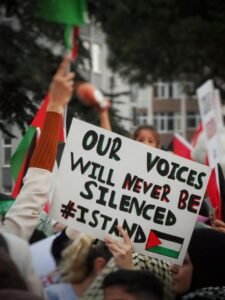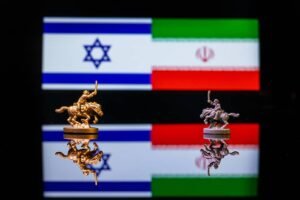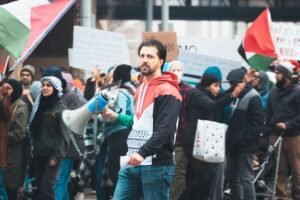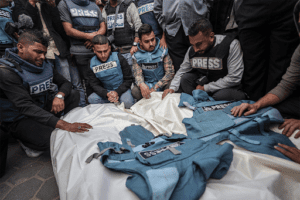All non-state military actors including rebels, guerrillas, insurgencies, terrorists, tribal fighters, and militias can vary in complexity; from small to large and from pro-state actors, to ones with political wings or associated social service networks. The sphere of those groups could be local, regional, or international. Many have official/non-official offices and military bases in various areas, regions, or states. Some exercise a bigger political impact than states. In this third and final part as editor in chief of Times For Palestine, I use the current status in Gaza and The Occupied Territories in the West Bank And Jerusalem to re-introduce the frame for ‘Patron’ and ‘surrogate’ states in order to explain empirically the dynamics of empowering or decaying Israel as a recognized state’s control over coercion, and the smashing attempt of Hamas seeking to have the military; therefore, the political upper hand on Gaza as territorial sovereignty. I will analyse how severe the change in the character of war in the Middle East has been since October 7.
In the first and second parts of this study, I identified Hamas as a militia with a national liberation goal. Ordinarily, the paradigm of militias in the Middle East changed in the last twenty years. Since the invasion of Iraq in 2003, “civil,” “ethnic,” and “tribal” militias in the Middle East have been of interest. Semi-military individuals, groups and organisations that work out of the state’s legal or normative coercive control over violence, especially in conflict zones where the state coercion, the rule of law or the sovereignty are failing are regarded by most policymakers as militias. This applies to both Hamas and Hizbullah.
Hamas, Israel and Patron or Sarrogate States:
Militias may be sponsored by a patron state as proxies, and some look to take over states they or their sponsors target. Militias must be violent by definition. One issue here is whether this violence is entitled or seeks to be legitimate as a coercive apparatus of the hosting or the patron state, or as an entity of their own. The difference between militias like Hamas and private arms lies in the national liberation goal that enforces a change in tactics, media narrative and image framing, while private arms are all for money following Resources Mobilisation Theory (RMT). Hamas and other liberation movements with armed wings usually have a political project, and violence is implemented to fulfil the group or the patron states’ goal of national independence. In this sense, Hamas, as a non-state actor must be armed, and politicised which uses violence to achieve a political programme.
Hamas, as a non-state player seeking to validate its existence and fulfil its goal, has one of three ways to change the game board and succeed politically after October 7; co-existence, complementarity or continuous confrontation covert or overt. The control over violence by Hamas is challenged by the dilemma the PLO faced decades ago while shifting gradually from military to political. This dilemma is Hamas’s ability to keep coercion within control and the growing resources and gains.
What Israel adopts toward Hamas now in reaction to that vast mobilisation and change of warfare tactics depends mainly on the support of the United States and Israel’s ideological compatibility with the American operational weight in the region. Hamas deeply shook that weight, pushing both Israel and its surrogate; The US to change the rules of engagement, hence the nature of war in the Middle East.
Hamas must very carefully draw their local strategies to gather their primer resources, market themselves or get marketed which is the case now on a global scale. If, at some point, Hamas chose or will choose to remobilize their resources, depend on a surrogate; some say Iran some assure it is Qatar, The movement should always mobilize accordingly with its local support or social casket. Support could be passive or positive from civilians in Gaza. The genocide committed by Israel in Gaza and the forced displacement of civilians from the North to the South of Gaza aim for two goals: a) evacuating the social casket off areas of Hamas’s support. b) exporting the bulk of the population in Gaza to neighbouring states such as Egypt once and for all.
Since the US intervention through the Arab Mujahedeen in Afghanistan throughout the 1980s, the Weberian definition of the state has been seriously challenged in the Middle East in the presence of the inevitable that proxy wars would be the safer approach to align the tribal elements instead of sending boots on the ground to defy the deployed Soviet troops. In 2003, the dismantling of the Iraqi army by Paul Bremer, leader of the US Coalition Provisional Authority (CPA) and the formation of the US-Iraqi Sunni Awakening militias ‘Sahawat’ in 2005, the Civil War in Syria 2012 and the war against IS 2014-2017 changed the face of war in the Middle East. This time is different. The US “Surge” plan for warfare in the Middle East cannot apply to the war on Gaza. There is no social community amongst Palestinians to turn into proxy fighters. There is only one militia of legitimacy and it seems that Hamas has forcibly taken the exclusive arrogation of coercion so far. The US fully understands that there is no civil community in Gaza or Palestinian Occupied Territories to deploy.
The ideological agenda of liberation that Hamas embraces, regardless of it being of Islamic leyer of identity can be a means of monopolising power. In the 1980s, Hamas called for armed insurrection against Israel as an occupying force. The nationalistic paradigm granted the movement both successful recruiting capacity amongst youth to join the resistance efforts. This success paved the way for two landmark victories for Hamas: 1) Gaining funding and support from patron states such as Syria, Iran, and later Gulf states. 2) legalising the militia in the Arab population’s conceptual mind and framing the PLO as the semi-state authority accepting a diplomatic path with the occupier (Israel) and bending to the hegemony of Israel’s Patron state (The US).
Hamas and the New Wars in the Middle East
In the Palestinian-occupied territories, Iran and Syria sponsored the armed factions of Hamas in the 1990s as military proxies, even though the ideology of the movement; being a branch of the Muslim Brothers was not compatible with either semi-autocratic rule in Syria or the Shi’ite Islamic rule in Iran since 1979. Hamas’s Palestinian nationalist and Islamic blueprint had its own political and probably military project, however, ‘Majd’ Militia, formed by Ahmed Yassin, an influencing leader of the movement in 1985 the aim to eventually cease power over the Gaza Strip and possibly other territories in the Wes Bank, decayingthePLO grip over both the political rule and the coercive violence sole handed in the Palestinian territories. Israel’s response to the formation of ‘Majd’ by Hamas in the 1980s strategically refrained from using coercive violence against the movement. On the contrary, Israel tactically recognised the Muslim Brothers’ social mobilization in Gaza in late 1978 through several charitable projects named ‘Al Mujamma”, even though Israel realised these projects and charitable works work on recruiting youthful elements in Hamas’s militia, on the hope to counterbalance the power of the PLO insurgencies.
In 1990 operation Desert Storm led by the US challenged the modern Western understanding of conventional warfare. The announcement of US President George W. Bush the end of hostilities in Iraq on May 1st, 2003 and his statement “We have witnessed the arrival of a new era” was a clear strategy of Bush and Defence Secretary Donald Rumsfeld that changed the face of war in the Middle East after the Iraq invasion. Now the ‘Survival’ and ‘ resistance’ Of Hamas trigger the change in warfare once more. The term ‘resistance’ has been a trade mark of Palestinians for decades and now to Hamas comes as a consequence of survival in case the group retained their recovery and position after either re-mobilising themselves or re-prioritising their targets.
This war on Gaza since October 7 is an irregular warfare between a state with a regular army (Israel) and a national liberating militia (Hamas). It is next to impossible for the former with conventional military forces to destroy Hamas completely to count themselves as ‘winning the war’. A second outcome of October 7 is for the surrogate state itself (The US), as this impossibility to wipe off Hamas or its civilian casket or the wider global conscience growing towards Palestine, may open other risk spots but not in the Middle East. Cornering Hamas trying to isolate it or expelling Palestinians into a neighbourhood state or elsewhere in the region will fail, simply because it is unsustainable. Surviving those eradication attempts by Israel is a battle of life or death. Israel could win the war. But for Hamas and the civilian Palestinians, surviving or ‘not losing’ in front of a far-advanced conventional army may require resistance factions to seek foreign funding, armament, or even military ally-ship. This opens the door for legal and illegal American intervention, therefore an external threat to Israel’s coercive ability and power over those occupied territories and, therefore sovereignty.
Reflecting once more on Machiavelli’s Art Of War, one can conclude military guidelines in the case of Neo-conservatives’ war and security philosophy applied in the Iraq invasion 2003; “In a battle, never use a company for some other purpose than what you have assigned it to, unless you want to cause disorder”. The contestation of Hamas in this case, however, changes the nature of war in the Middle East as non-state military actors that excelled over both the PLO and Israel in mobilisation and tactics.









